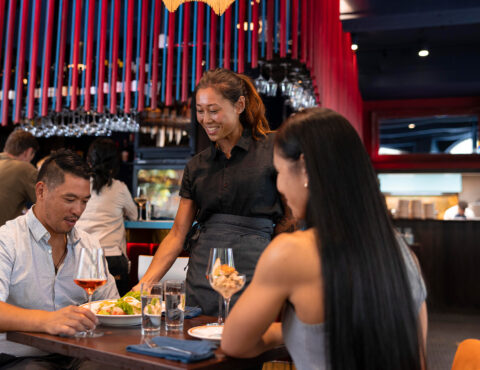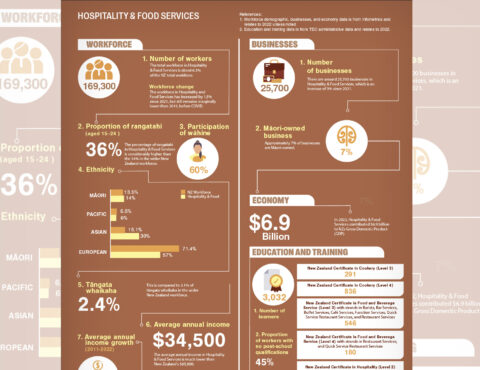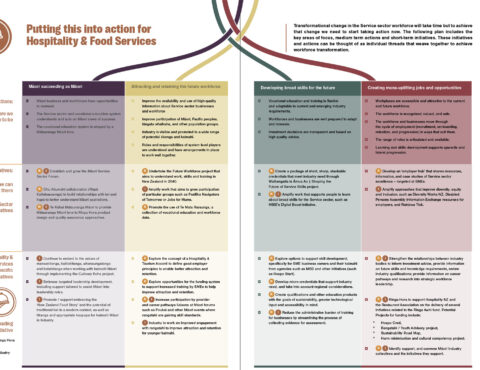Ringa Hora has worked with people from across industry to develop a shared roadmap to transform the Service sector workforce from its current state to the future that we aspire to.
The Workforce Development Plan looks across the Service sector and sets out the major factors shaping the sector and an overarching vision for the future.
Against that context, this Action Plan focuses on the characteristics and dynamics of the Hospitality & Food industry and its workforce.
It describes what the future could look like for this workforce, the current challenges faced by the industry, and sets out the actions we can take to tackle this wero | challenge.
Ringa Hora’s Service Sector Workforce Development Plan is based on four aho | strands. Each of these aho will strengthen the workforce, but when woven together, as a taura whiri | rope, we can achieve real transformation of the workforce:
The Hospitality & Food Services sector will continue to act as a gateway for many kaimahi entering the workforce or looking to change careers. The nature of the industry is vast and diverse, offering a range of opportunities for people to advance and gain valuable life-long experience which will serve them wherever they go; whether that be marketing, culinary roles, front of house, management, or beyond.
This future vision amplifies opportunities not just for Māori in the industry, but for everyone by sharing the unique identity of Aotearoa through hospitality & food. There are already every day opportunties to give life to and experience Te Ao Māori values, such as, manaakitanga.1

Hospitality & Food Services provides the people of Aotearoa with opportunities to come together and experience something positive. From both an economic and social perspective, the Hospitality & Food Services industry is essential. It contributed $6.9 billion dollars to GDP in 2022, while providing the backdrop to the memories and experiences that many visitors and locals alike enjoy every day.
The Hospitality & Food Services industry includes a wide range of businesses from hotels, to cafes, to fast food restaurants. With such a wide range of businesses, there is also a variety of jobs, including many that are entry points into the workforce. Hospitality businesses offer many rangatahi their first chance of employment, and the skills they gain will equip them for the rest of their life.
The industry dovetails neatly with our Tourism and Accommodation sectors, so it is relevant to consider the Government backed Tourism Industry Training Plan (ITP). This ITP establishes a set of operating principles for businesses to sign-up to assist with attraction and retention. Widespread adoption of such an accord may assist with identifying and providing examples of what good workplace culture and best practise looks like for both industries. In the long term, such an initiative may then drive better employment conditions for kaimahi.

To help us get to the desired future state, we need to understand and tackle the challenges that the Hospitality & Food Services sector faces, while also seizing the opportunities that already exist or are on the horizon. We’ve heard that the factors having a significant impact on workforce development for the Hospitality & Food Services industry include skills and labour shortages, staff burnout, the need for fit-for-purpose training and career pathways, and the impact of rising operating costs and inflationary pressures.
Addressing skills and labour shortages
The Hospitality & Food Services industry is currently facing a skills and labour shortage at unprecedented levels. In a recent survey, the Restaurant Association published that up to 62% of business respondents had to temporarily close due to ongoing staffing shortages. In addition, they reported that 80% of members are running establishments that are not fully staffed, and 56% of respondents indicated that recruiting for junior roles was challenging3.
Competition for employees within the industry and with other industries is at a peak, with many fighting for the same pool of available workers. Anecdotally, Hospitality workers were willing to change employers for an extra $1-$2 per hour.
Businesses are increasing their reliance on migration to help fill existing labour shortages. However, immigration settings have also impacted on the ability to recruit skilled kaimahi. Chefs are a particularly in-demand occupation, yet it is hard to fill this gap through migration.
Promoting worker retention
Worker retention is a significant issue for the industry, with only a third of workers making it to a year of tenure. Good working conditions, paying a competitive wage and investing in training and professional development are strategies recommended to prevent staff leaving and joining other businesses.
Addressing staff burnout
With the ongoing staff shortages, many staff employed in the sector have had to work longer hours in recent years, including often covering multiple roles. Business owners and management staff have also been active in assisting with front of house operations given staff shortages. Dealing with such episodes, low staffing and long hours are all contributing factors that have reportedly had a significant toll on the workforce and contributed to burn out and stress.
Developing fit-for-purpose training and career pathways
The Hospitality & Food Services industry needs to create consistent pathways for kaimahi within the industry. This would encourage more employees to work in the sector for longer and build their skills and knowledge as they progress. Sufficient and fit for purpose training is essential to this. However, many small businesses within industry often have limited time, administrative capacity or resource to offer this training due to the frequently small staff cohort and relatively flat structure.
Recognising the impact of increasing operating costs
Many businesses in the industry have been reducing opening hours (due to staff shortages) and at the same time, inflation has been rising and incurring greater costs on fresh produce and consumables impacting on profit margins. These inflationary pressures further limit the ability of businesses to hire more staff, offer appropriate training or more competitive wages.
New Zealand’s Hospitality & Food Services workforce truly provides the ‘face’ of our nation.
Our Hospitality workers are to be found everywhere, from the most remote regions, to right across every restaurant, bar, club and café in our urban centres. It is a large workforce of 169,300 people, whose expertise, experiences and skills contribute to a lasting impression of professionalism and standards of service that is the backbone of much that we provide socially and as an international destination.
Embracing and celebrating diversity makes businesses more attractive to potential kaimahi and customers, as well as creating economic and social benefits for employers, the workforce, and the wider community.
Using workforce participation data as a starting point shows that there is work to be done in the Hospitality & Food Services industry to realise the aspirations and potential of Māori, Pacific peoples, and tāngata whaikaha | disabled people:
![]()
901 businesses identified as dedicated Māori business interests (2021). Within the sector there are a range of vocations, however, many Māori are concentrated in roles within catering, clubs and pub spaces with fewer focused on cafes and accommodation. It is important that Māori within the workforce feel accepted and reflected within the industry.
![]()
Despite the relatively low proportion of Pacific peoples in the industry, the number accounts for over 10% of all Pacific peoples employed in the Service sector. Recently, Government has been promoting and supporting Pacific entrepreneurship through the Pacific Economic Action Plan, resulting in the growth of Pacific-owned restaurants, cafes, and catering businesses. It is important that these government initiatives continue to be available and enable Pacific peoples to create careers and business opportunities that reflect their cultural values and aspirations.
![]()
Tāngata whaikaha includes physical, mental, intellectual, or sensory impairments which can impact a person’s life to varying degrees and in different ways. We acknowledge that data on tāngata whaikaha is limited and it is important that we create more growth opportunities within the sector for our tāngata whaikaha workforce.

Explore the Hospitality & Food industry workforce demographic, business, and economy statistics, and education and training data.

Transformational change in the Service sector workforce will take time but to achieve that change we need to start taking action now. The Hospitality & Food action plan includes the key areas of focus, medium-term actions and short-term initiatives. These initiatives and actions can be thought of as individual threads that weave together to achieve workforce transformation.